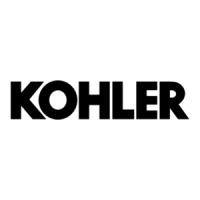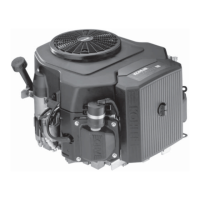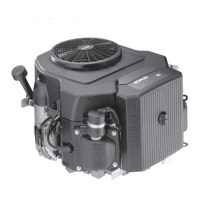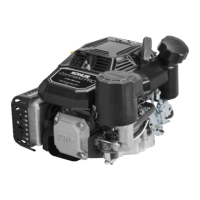Fuel System
24
24 690 07 Rev. H
KohlerEngines.com
Typical carbureted fuel system and related components
include:
● Fuel tank and valve.
● Fuel lines.
● In-line fuel lter.
● Fuel pump.
● Carburetor.
Fuel from tank is moved through in-line lter and fuel
lines by fuel pump. Fuel then enters carburetor oat bowl
and is drawn into carburetor body and mixed with air.
This fuel-air mixture is then burned in engine combustion
chamber.
FUEL RECOMMENDATIONS
Refer to Maintenance.
FUEL LINE
Low permeation fuel line must be installed on carbureted
Kohler Co. engines to maintain EPA and CARB
regulatory compliance.
FUEL PUMP
Some engines use a pulse style fuel pump. Pumping
action of pulse style pumps is created by oscillation of
positive and negative pressures within crankcase. This
pressure is transmitted to pulse pump through rubber
hose connected between pump and crankcase. Pumping
action causes diaphragm on inside of pump to pull fuel
in on its downward stroke and to push it into carburetor
on its upward stroke. Two check valves prevent fuel from
going backward through pump.
FUEL SYSTEM TESTS
When engine starts hard or turns over but will not start, fuel system might be causing problems. Test fuel system by
performing following test.
1. Check for fuel in combustion chamber.
a. Disconnect and ground spark plug leads.
b. Close choke on carburetor.
c. Crank engine several times.
d. Remove spark plug and check for fuel at tip.
2. Check for fuel ow from tank to fuel pump.
a. Remove fuel line from inlet tting of fuel pump.
b. Hold line below bottom of tank. Open shut-off
valve (if equipped) and observe ow.
Performance
Minimum fuel delivery rate must be 7.5 L/hr. (2 gal./hr.)
with a pressure at 0.3 psi and a fuel lift of 24 in. A 1.3 L/
hr. (0.34 gal./hr.) fuel rate must be maintained at 5 Hz.
Fuel Pump Replacement
NOTE: Make sure orientation of new pump is consistent
with removed pump. Internal damage may occur
if installed incorrectly.
Replacement pumps are available through your source
of supply. To replace pulse pump follow these steps.
Note orientation of pump before removing.
1. Disconnect fuel lines from inlet and outlet ttings.
2. Remove screws (securing pump) and fuel pump.
3. Remove pulse line that connects pump to
crankcase.
4. Install a new pump using screws.
5. Connect pulse line between pump and crankcase.
6. Torque screws to 2.3 N·m (20 in. lb.).
7. Connect fuel lines to inlet and outlet ttings.
3. Check operation of fuel pump.
a. Remove fuel line from inlet tting of carburetor.
b. Crank engine several times and observe ow.
Condition Conclusion
Fuel at tip of spark plug. Fuel is reaching combustion chamber.
No fuel at tip of spark plug. Check fuel ow from fuel tank (step 2).
Fuel ows from fuel line. Check for faulty fuel pump (step 3).
If fuel pump is working, check for faulty carburetor. Refer
to Carburetor.
No fuel ow from fuel line. Check fuel tank cap vent, fuel pickup screen, in-line
lter, shut-off valve, and fuel line. Correct any observed
problem and reconnect line.
Fuel line condition. Check for a clogged fuel line. If fuel line is unobstructed,
check for overlled crankcase and/or oil in pulse line. If
checks don't reveal cause of problem, replace pump.
